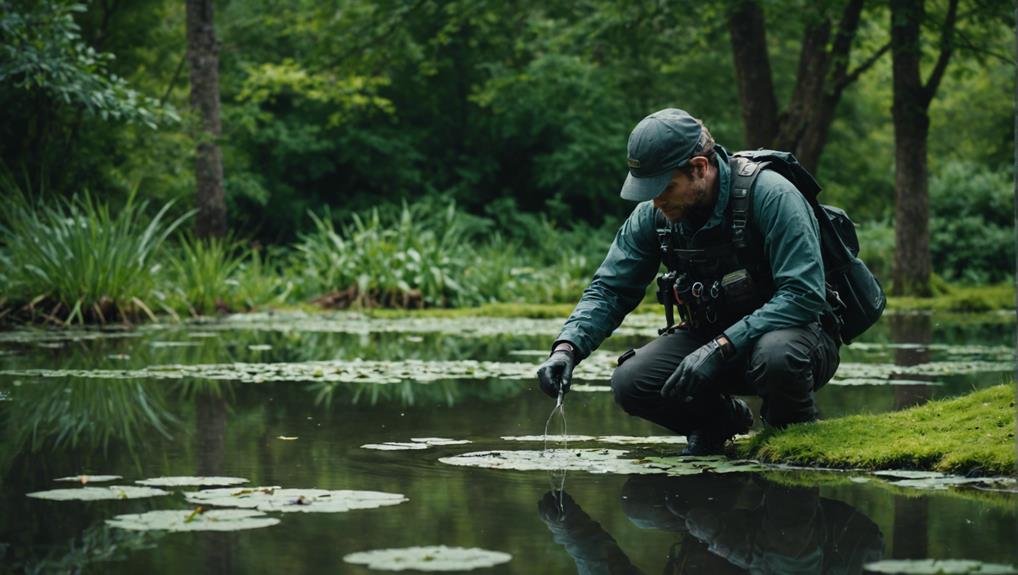Fixing pond leaks without draining the water is possible through practical methods. To start, identifying the leak by inspecting the pond's surface and edges for soft spots or exposed gravel is key.
Once found, using a pond liner patch kit can be effective. This involves cleaning the leak area and applying an adhesive patch. Another option is to apply waterfall foam, which expands to seal gaps efficiently.
Adjusting pumps and filters to redirect water flow can also aid in fixing leaks. Regularly monitoring water levels for 24 hours after applying these fixes ensures they are holding up well.
By utilizing these methods, you can maintain your pond in excellent condition without the hassle of draining it.
Identifying the Leak
When trying to locate a leak in your pond liner, it can be challenging, but being aware of certain signs can make the process easier. The first step in addressing a leaking pond is to carefully inspect it. One common indicator of a pond leak is the absence of algae patches or areas where algae appears to be drawn towards a specific spot, suggesting a possible hole in the liner where water is escaping.
Another strategy to consider is partially draining the pond. Lowering the water level may reveal previously submerged holes. However, the goal is to find the leak without completely emptying the pond. Thoroughly examining the pond's surface and edges is crucial. While bubbles may sometimes be visible, they can be difficult to spot due to water pressure forcing air into the surrounding soil, complicating detection.
A comprehensive search is essential. Walking around the pond and checking for soft spots or exposed gravel may accidentally reveal holes. This method demands patience and keen attention to detail, but it can help pinpoint the source of the leak without the need to drain the entire pond, ultimately saving time and effort in the long term.
Using a Pond Liner Patch Kit
Once we locate the leak in our pond, we can use a pond liner patch kit to seal it effectively without the need to drain the pond. These kits include patching material and adhesive specially designed for fixing pond liners, making them user-friendly and highly efficient.
To start, we need to clean the area around the leak thoroughly to ensure the patch sticks properly. Following the instructions provided in the kit is crucial for a successful repair. The patching material is strong and waterproof, offering a durable solution to our pond liner problem.
The repair process involves three steps:
- Cleaning: Clearing the area around the leak is essential to ensure the patch adheres well.
- Applying: Applying adhesive to the patch material secures it to the pond liner effectively.
- Pressing: Pressing the patch firmly over the leak guarantees a watertight seal.
Using a pond liner patch kit enables us to address small to medium-sized holes or tears without the inconvenience of draining the entire pond. This not only saves time but also preserves the balance of our pond ecosystem.
Applying Waterfall Foam

When dealing with leaks around the pond liner, using waterfall foam can efficiently seal the gaps and prevent water from escaping. This special foam expands to fill any voids, ensuring a tight seal on various surfaces like stone, concrete, and the pond liner itself. It's designed to withstand UV exposure, ensuring durability even when exposed to sunlight. The foam is safe for fish and plants in the pond, making it a reliable choice for maintaining the aquatic ecosystem.
With a curing time of approximately 30 minutes, we can quickly proceed with our pond maintenance tasks. Once fully cured, the foam can be easily trimmed to fit the natural shape of the pond, enhancing both functionality and aesthetics.
Redirecting Water Flow
Redirecting water flow plays a critical role in preventing leaks from worsening and causing further damage to your pond. It's essential to identify where the water is escaping from so that appropriate measures can be taken to redirect it effectively.
One effective way to manage water flow and reduce leaks is by adjusting the positioning of pumps, filters, or water features without the need to completely drain the pond. This approach is particularly beneficial for ponds with a high clay content at the bottom, as it helps maintain the pond's structure while minimizing water loss.
To begin, carefully inspect your pond to locate areas where water is escaping. This step is crucial in pinpointing the specific areas that require attention. Once the leak areas are identified, adjust the equipment such as pumps, filters, or water features to optimize the water flow within the pond. By repositioning these elements strategically, you can effectively control the water movement and reduce the risk of leaks.
It is important to monitor the results of these adjustments by regularly checking for changes in water levels. By keeping an eye on the water level, you can ensure that the measures taken are successful in minimizing leaks and preserving the integrity of your pond.
Maintaining Pond Water Level

Now that we've successfully redirected water flow to reduce leaks, our next focus is on maintaining the pond water level to ensure a stable and healthy environment.
It's crucial to regularly check for leaks by observing the water level over 24 hours. If there's any water loss, we need to gradually lower the water level to locate the source of the leak. During this process, it's important to use a holding tank with an aerator to keep our fish safe.
Once the leak is identified, we can patch the pond liner or repair any faulty connections. Thoroughly inspecting the liner and connections is essential to address all potential leak points. By utilizing the surrounding soil, we can create a natural and secure seal to prevent further water loss.
After completing the repairs, it's advisable to recheck the water level to ensure that the leaks have been fixed. By following these steps, we can maintain the pond's water level without the need to drain it completely.
This approach not only conserves water but also promotes a sustainable and thriving pond environment for our aquatic life.
Conclusion
Fixing pond leaks without draining the water is a practical and efficient solution. Each year, around 30% of pond owners encounter leakage problems.
By pinpointing the leak, using a pond liner patch kit, applying waterfall foam, and adjusting water flow, we can maintain the proper water levels without the need for draining.
These methods not only save time but also help protect the pond's ecosystem. Regular maintenance is key to ensuring a healthy, leak-free pond.

